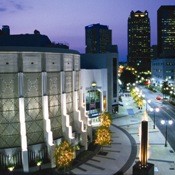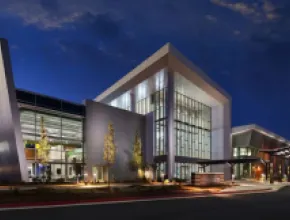Long known as the “Magic City,” Birmingham is proof that a lot of hard work and a little abracadabra can turn an historic industrial center into a bustling metro and cultural beacon of the South. With compelling attractions like the Birmingham Museum of Art and the Birmingham Civil Rights Institute, as well as a variety of new meetings-friendly developments, the city combines a sophisticated infrastructure with intriguing diversions and a history too important to forget.
Planning for Tomorrow
The last few years have been an exciting time for Alabama’s largest city, with improvements to the Birmingham-Jefferson Convention Complex (BJCC) and a host of new projects coming into town.
The biggest news is the entertainment district that broke ground in May next to the convention complex. The $55 million project, tentatively called the District at the BJCC, will encompass a two- to three-block area, bringing new shops, restaurants and entertainment options into the area, as well as a 100-room hotel. The project is being spearheaded by the same developer that breathed new life into Memphis’ Beale Street.
The District at the BJCC has spurred other developers into action. Plans are being discussed to add approximately 700 rooms to the area surrounding the BJCC within the next couple of years, solving a growing problem of room shortages when large conventions come to town. According to a report by the Birmingham News, one developer is looking into building a 300-room hotel connected to the new entertainment district, and the 757-room Sheraton Birmingham, which is located adjacent to the BJCC, is considering a 300-room expansion of its own.
“Right now, we don’t have enough rooms around town within walking distance of the BJCC,” says Barry Hoehn, director of sales for the Greater Birmingham CVB, adding that the availability of rooms has also been affected by the city’s amazing growth in the sports market. “The attendees with the sports events stay around the parks they are playing in, and it’s created pressure from outside toward the city center. They’re filling the perimeter hotels around the sports complexes, and the downtown hotels are dealing with the overflow as well as clients from the convention center.”
Although SMERF groups are one of Birmingham’s most important markets, a rising number of softball, baseball and other sports association events has prompted the creation of a separate sports sales division within the CVB, according to Hoehn.
“This market has taken off really well,” he says.
Aside from the District at the BJCC, the convention complex is in the midst of a major renovation and expansion project. Numerous upgrades have already been completed, and the next phase includes a new 40,000-seat arena that will also serve as an exhibition hall with 167,000 square feet of floor space. Once the arena expansion is approved, Hoehn estimates that it will take 18 to 24 months to complete the project. The BJCC currently features 220,000 square feet of exhibit space, 74 meeting rooms, a 3,000-seat concert hall, and a 1,000-seat theater.
Other Birmingham venues for large groups include the Harbert Center, which can handle up to 1,000 attendees, and the Boutwell Municipal Auditorium, which can accommodate up to 5,700 delegates.
Meanwhile, several hotels are also under construction. In 2008, four new properties will debut: the Hyatt Place Downtown, the Residence Inn Birmingham, the Holiday Inn Lakeshore Drive, and the Hampton Inn and Suites–Irondale. Additionally, the Lexington Collection Hotel is slated to open in 2008 or 2009 in downtown Birmingham, and an Embassy Suites will open in 2009 in Hoover, a suburb of Birmingham.
Hoover is also the site of the Renaissance Ross Bridge Golf Resort and Spa, which was unveiled in 2005. The property sits on the Robert Trent Jones Golf Trail and features the 18-hole Ross Bridge course and 27,000 square feet of meeting space.
Discovering Today’s Treasures
While the future looks extremely bright for Birmingham, the city already has a great deal to offer planners.
Birmingham’s culinary scene features some of the finest independent restaurants in the country, according to Hoehn. Naturally there’s a tempting array of down-home and nouveau Southern cooking, but the city’s many eateries also serve cuisine such as Thai, Mongolian, Japanese, Middle Eastern, Lebanese, and Latin.
After a great meal, meeting attendees also enjoy the city’s nightlife, especially in recently retooled parts of town like the historic Five Points South area.
“We have a ton of things to do that surprises people,” Hoehn says. “They don’t think about our incredible diversity, but when they get here, they’re so surprised.”
One of Birmingham’s best personality traits is its long-held devotion to retaining its Southern flavor, from the historic preservation of buildings and landmarks to designing new developments that reflect its unique charm.
Finding the heart of the city is as easy as driving to Vulcan Park, which reflects Birmingham’s past and future. The park sits atop Red Mountain, with a 10-acre green space surrounding the massive statue of Vulcan, dedicated to the mythological god of metalworking, a fitting symbol of Birmingham’s industrial past in iron production. Birmingham’s Vulcan is the largest cast-iron statue in the world. A popular site for group picnic lunches, the park offers unparalleled views of the city as well as interactive historical exhibits.
Another group favorite is the Sloss Furnaces National Historic Landmark, which illustrates the town’s industrial past and also keeps the metal arts alive with classes and events.
In keeping with its new tagline, the “Diverse City,” Birmingham offers cultural pursuits for everyone’s tastes, from the high-speed thrills of stock car racing to the quiet pleasures of art galleries and ballet performances.
Racing enthusiasts will be drawn to Barber Motorsports Park, Birmingham International Raceway and the nearby Talladega Superspeedway. Each race facility offers a wide range of packages for groups. Groups can also go the extra mile for a car-themed meeting at Ted’s Garage, an event center and vintage car garage that can handle up to 500 attendees.
Birmingham’s art venues are also star attractions as well as unique off-site event venues. The Birmingham Museum of Art has become a noted presence in the national arts scene, with more than 21,000 works of art from nearly every age and culture. The museum is one of only three hosting the international exhibit Pompeii: Tales of an Eruption, a collection illustrating the final days of the doomed village. Planners can host a variety of events at the museum, including receptions in the sculpture garden, meetings in the 340-seat auditorium and dinners in the bright and spacious lobby. For an intimate artistic setting, the Chris McNair Studios and Art Gallery offers banquet space for up to 250 people amid the artist’s historic photographs of the Civil Rights era, while the Alys Robinson Stephens Performing Arts Center can handle up to 1,330 attendees in the Jemison Concert Hall. The performing arts center hosts a full schedule of dance and music performances, as well as other cultural events.
Another must-see attraction is the Birmingham Civil Rights Institute. The institute’s permanent collection, ranging from the Freedom Riders bus replica to a segregated streetcar, is a powerful tribute to those who paved the way in the Civil Rights Movement. Group tours are available, and the institute also has meeting space for up to 300 people.
For More Info
Greater Birmingham CVB 205.458.8000
www.thediversecity.org






